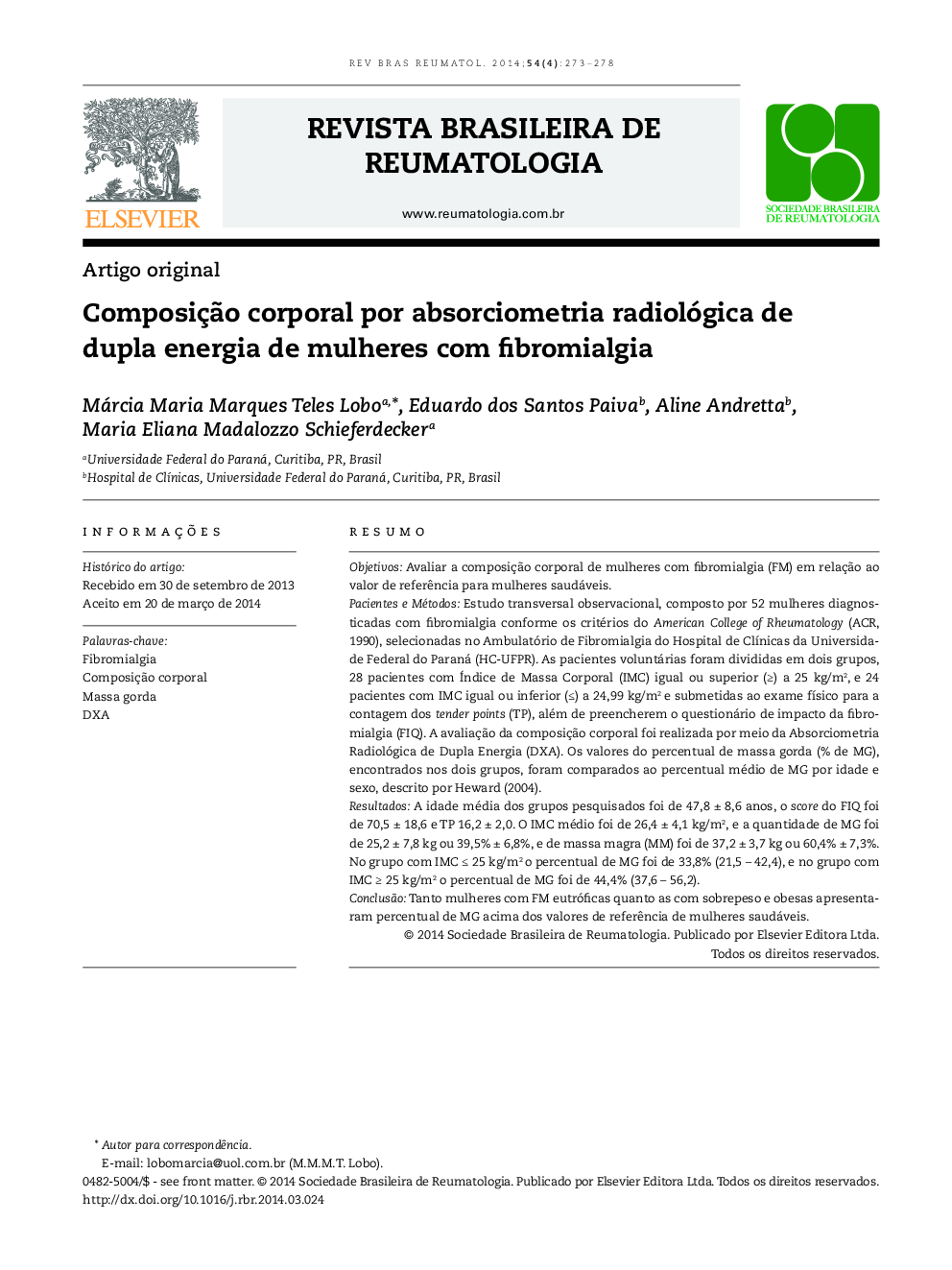| Article ID | Journal | Published Year | Pages | File Type |
|---|---|---|---|---|
| 3327074 | Revista Brasileira de Reumatologia | 2014 | 6 Pages |
ResumoObjetivosAvaliar a composição corporal de mulheres com fibromialgia (FM) em relação ao valor de referência para mulheres saudáveis.Pacientes e MétodosEstudo transversal observacional, composto por 52 mulheres diagnosticadas com fibromialgia conforme os critérios do American College of Rheumatology (ACR, 1990), selecionadas no Ambulatório de Fibromialgia do Hospital de Clínicas da Universida‐de Federal do Paraná (HC‐UFPR). As pacientes voluntárias foram divididas em dois grupos, 28 pacientes com Índice de Massa Corporal (IMC) igual ou superior (≥) a 25 kg/m2, e 24 pacientes com IMC igual ou inferior (≤) a 24,99 kg/m2 e submetidas ao exame físico para a contagem dos tender points (TP), além de preencherem o questionário de impacto da fibromialgia (FIQ). A avaliação da composição corporal foi realizada por meio da Absorciometria Radiológica de Dupla Energia (DXA). Os valores do percentual de massa gorda (% de MG), encontrados nos dois grupos, foram comparados ao percentual médio de MG por idade e sexo, descrito por Heward (2004).ResultadosA idade média dos grupos pesquisados foi de 47,8 ± 8,6 anos, o score do FIQ foi de 70,5 ± 18,6 e TP 16,2 ± 2,0. O IMC médio foi de 26,4 ± 4,1 kg/m2, e a quantidade de MG foi de 25,2 ± 7,8 kg ou 39,5% ± 6,8%, e de massa magra (MM) foi de 37,2 ± 3,7 kg ou 60,4% ± 7,3%. No grupo com IMC ≤ 25 kg/m2 o percentual de MG foi de 33,8% (21,5 – 42,4), e no grupo com IMC ≥ 25 kg/m2 o percentual de MG foi de 44,4% (37,6 – 56,2).ConclusãoTanto mulheres com FM eutróficas quanto as com sobrepeso e obesas apresentaram percentual de MG acima dos valores de referência de mulheres saudáveis.
ObjectivesTo assess body composition in women with fibromyalgia (FM) comparing to the reference value for healthy women.Patients and MethodsCross‐sectional observational analytical study, with 52 women selected with Fibromyalgia, according American College of Rheumatology (ACR, 1990) criteria. The patients were selected in Hospital de Clínicas da Universidade Federal do Paraná (HC‐UFPR) and divided into two groups, 28 patients with a BMI (Body Mass Index) equal or higher (≥) than 25 kg/m2 and 24 patients with BMI less or equal (≤) 24.99 kg/m2, subjected to physical examination for the count of tender points (TP) and completing the fibromyalgia impact questionnaire (FIQ). The assessment of body composition was performed by the Dual‐Energy X‐Ray Absorptiometry (DXA). The values of the fat mass percentage (MG %) found in the two groups were compared to the average percentage of MG by age and sex, described by Heward (2004).ResultsThe mean age of the study groups was 47.8 ± 8.6 years, the FIQ score was 70.5 ± 18.6 and TP 16.2 ± 2.0. The mean BMI was 26.4 ± 4.1 kg/m2, and the amount of MG was 25.2 ± 7.8 kg and 39.5 ± 6.8%, and lean mass (LM) was 37 2 ± 3.7 kg and 60.4 ± 7.3%. In the group with BMI ≤ 25 kg/m2, the MG % was 33.8% (21.5 ‐42.4) and in the group with BMI ≥ 25 kg/m2 of the MG was 44.4% (37.6 ‐56.2).ConclusionBoth groups women with FM eutrophic as the overweight and obese group, presented higher reference MG% levels comparing with the standard levels for healthy women.
